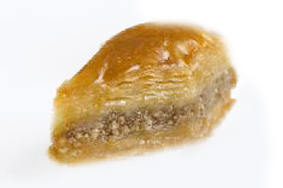
What is Hadef?
Hadef is known among Palestinian as an ancient dessert for holidays. It is made of mouthwatering walnuts sandwiched between fine layers of our great grandfather's secret recipe dough and baked with care and affection. The combination of thin crispy dough and juicy walnuts will invoke all your senses and bring back old memories. Ingredients Semolina, sugar, flour, walnut, corn oil, salt. Characteristics Hadef is by far the most difficult to make and the most skill intensive among all Palestinian sweets types. Very few people even know how to make it these days. The difficulty resides in the preparation of the semolina and oil dough which is kneaded by hand with special techniques to form extremely thin sheets of dough. Even though it looks like walnuts filled Baklava, Hadef is made of a completely different dough than that used in Baklava, tastes different than Baklava, and requires much more skills than those required to make Baklava. Moreover, it requires much more time to prepare than Baklava. Because of the type of dough used, it has a very short shelf like and stays fresh for only about three days after baking. Meaning and Pronunciation of «Hadef» Pronounced [ha-dif], it comes from the Palestinian verb «hadafa» which means «throw». It is named as such because while making Hadef, the dough is thrown many items against a large marble in order to increase its area and decrease its thickness. How is Hadef Made? The thin semolina dough and the sugar syrup are first prepared. Then Hadef diamonds consisting of raw nuts sandwiched between multi-layered dough are prepared and baked. Preparation of Hadef Dough Hadef is made of a semolina and oil dough. The dough is very rich in oil and is kneaded extremely thin. To make the dough, semolina, water, oil, and a hint of salt are mixed together. Then the dough is cut into small balls, and each ball is kneaded extensively to form a very thin layer of dough. The kneading of the semolina based oily dough by hand is very difficult, time consuming, and requires extensive skills. Each small ball of dough is manipulated by hand and thrown against a large marble many times until its diameter reaches about one meter. Preparation of Sugar Syrup To prepare sugar syrup, generous amounts of sugar are added to water and heated at very high temperature to dissolve the sugar in the water. The mix is brought to a boiling point after which a hint of lemon is added and the resulting sugar syrup is then left to cool. Preparation of Hadef About twelve layers of the extremely thin Hadef dough are stacked on top of each other. Next, the filling consisting of raw walnuts with a hint of sugar is added on top of the dough. Afterwards, another stack of twelve layers of thin dough is prepared and placed on top of the walnuts resulting in a thick layer of walnuts sandwiched between two layers of dough. Finally, the walnuts filled dough is cut into diamonds of the desired size. Baking The Hadef diamonds are placed on a baking sheet and baked for about one hour on medium temperature. After baking, sugar syrup is added on top. Serving Suggestions Hadef is a sweet dessert usually served during the month of Ramadan in Lebanon. It can be served either alone or within arrangements of assorted Baklava. Popularity Hadef is only popular in Lebanon, and more specifically in Beirut. It used to be much more popular 50 years ago than it is today. Because it is very time consuming to make and it requires very high skills, many people stopped making it and its skills have been gradually lost. Even today, you cannot find it in Palestinian sweets stores and it usually needs to be done as a special order. It has been largely substituted with walnuts filled Baklava. Classification Hadef is one of the assorted Baklava pastries that is made with phyllo-like dough. Its dough however is much more difficult to make and more time consuming than regular phyllo dough. It is strictly a Palestinian pastry.
 Mahroum Sweets From Nazareth
Mahroum Sweets From Nazareth